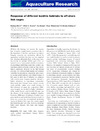Identificador persistente para citar o vincular este elemento:
https://accedacris.ulpgc.es/jspui/handle/10553/106641
| Campo DC | Valor | idioma |
|---|---|---|
| dc.contributor.author | Riera, Rodrigo | en_US |
| dc.contributor.author | Becerro, M.A. | en_US |
| dc.contributor.author | Ramos, E. | en_US |
| dc.contributor.author | Monterroso, O. | en_US |
| dc.contributor.author | Rodríguez, M. | en_US |
| dc.date.accessioned | 2021-04-08T13:46:43Z | - |
| dc.date.available | 2021-04-08T13:46:43Z | - |
| dc.date.issued | 2015 | en_US |
| dc.identifier.issn | 1355-557X | en_US |
| dc.identifier.uri | https://accedacris.ulpgc.es/handle/10553/106641 | - |
| dc.description.abstract | Off‐shore fish farming can increase the organic load of nearby coastal marine ecosystems due to the deposition of fish food and faeces on seabeds. Seagrass meadows are particularly affected by aquaculture activities but there are few empirical data showing differential effects of the same farming activity on multiple habitat types. Here, we assessed over a 2‐year period whether macrofaunal assemblages inhabiting sandy bare seabeds and Cymodocea nodosa meadows varied in their macrofaunal community structure to the fish farming activities. We observed high spatial and temporal variability in macrofauna composition and dynamics among seabed habitats and a limited impact of fish cages in their area of influence as compared with control areas. Seagrass meadows showed a higher abundance in macrofauna communities than sandy bare bottoms. Local marine currents could partially explain some results because of their influence on grain size composition. Differences in grain size resulted in higher abundances of the tanaid Apseudes talpa beneath fish cages and the absence of the sensitive amphipod Ampelisca brevicornis. Differences of resilience of seabeds (seagrass meadows and sandy bare bottoms) should be taken into account for environmental monitoring studies of off‐shore fish cages. Our results suggest that hydrodynamics are a key factor to determine buffer areas between fish cages and seagrass meadows. | en_US |
| dc.language | eng | en_US |
| dc.relation.ispartof | Aquaculture Research | en_US |
| dc.source | Aquaculture Research [ISSN 1355-557X], v. 46, p. 1490-1500 | en_US |
| dc.subject | 240119 Zoología marina | en_US |
| dc.subject.other | Fish cages | en_US |
| dc.subject.other | Buffer area | en_US |
| dc.subject.other | Seagrass | en_US |
| dc.subject.other | Sandy seabeds | en_US |
| dc.subject.other | Macrofauna | en_US |
| dc.title | Response of different benthic habitats to off-shore fish cages | en_US |
| dc.type | info:eu-repo/semantics/Article | en_US |
| dc.type | Article | en_US |
| dc.identifier.doi | 10.1111/are.12306 | en_US |
| dc.identifier.scopus | 2-s2.0-84928275494 | - |
| dc.contributor.orcid | #NODATA# | - |
| dc.contributor.orcid | #NODATA# | - |
| dc.contributor.orcid | #NODATA# | - |
| dc.contributor.orcid | #NODATA# | - |
| dc.contributor.orcid | #NODATA# | - |
| dc.description.lastpage | 1500 | en_US |
| dc.identifier.issue | 6 | - |
| dc.description.firstpage | 1490 | en_US |
| dc.relation.volume | 46 | en_US |
| dc.investigacion | Ciencias | en_US |
| dc.type2 | Artículo | en_US |
| dc.identifier.external | 12829611 | - |
| dc.description.numberofpages | 11 | en_US |
| dc.utils.revision | Sí | en_US |
| dc.identifier.ulpgc | No | en_US |
| dc.contributor.buulpgc | BU-BAS | en_US |
| dc.description.sjr | 0,79 | |
| dc.description.jcr | 1,606 | |
| dc.description.sjrq | Q2 | |
| dc.description.jcrq | Q2 | |
| dc.description.scie | SCIE | |
| item.grantfulltext | open | - |
| item.fulltext | Con texto completo | - |
| crisitem.author.dept | GIR ECOAQUA: Biodiversidad y Conservación | - |
| crisitem.author.dept | IU de Investigación en Acuicultura Sostenible y Ecosistemas Marinos (IU-Ecoaqua) | - |
| crisitem.author.dept | Departamento de Biología | - |
| crisitem.author.orcid | 0000-0003-1264-1625 | - |
| crisitem.author.parentorg | IU de Investigación en Acuicultura Sostenible y Ecosistemas Marinos (IU-Ecoaqua) | - |
| crisitem.author.fullName | Riera Elena, Rodrigo | - |
| Colección: | Artículos | |
Citas SCOPUSTM
3
actualizado el 08-jun-2025
Citas de WEB OF SCIENCETM
Citations
1
actualizado el 08-jun-2025
Visitas
144
actualizado el 11-ene-2025
Descargas
5
actualizado el 11-ene-2025
Google ScholarTM
Verifica
Altmetric
Comparte
Exporta metadatos
Los elementos en ULPGC accedaCRIS están protegidos por derechos de autor con todos los derechos reservados, a menos que se indique lo contrario.
